Garden flower brugmansia: reproduction, planting and care
Long-flowering shrubs are often found in landscaping. They are the decoration of carpet flower beds, lawns... The bushes planted in tubs serve as a decoration for the main entrance or terrace. Such perennials include brugmansia, which attracts attention with huge flowers on a shrub two meters high.
Brugmansia is home to the South American subtropics. By the appearance of the flowers, the plant is called dope, the trumpets of an angel, by its poisonous properties - a demon tree, since the sap and aroma of some types of shrubs causes hallucinations.
Content:
- Description of brugmansia, its types
- Reproduction methods
- All about planting a plant
- Flower care: watering, feeding, pruning
- About diseases and pests of the plant, the fight against them
Description of brugmansia, its types
The perennial plant belongs to the Solanaceae family, and looks like a dope. In addition to the lush foliage of the tree-like bush, the decoration is funnel-shaped flowers up to half a meter long, and twenty centimeters in diameter. The shape of large leaves of the shrub is oval with slightly wavy edges. Veins are clearly visible on the surface of the green plates. The leaves are arranged in tiers on the bushes.
There are several types of brugmansia, differing in the color of the bell-like flowers:
- The most common types include tree brugmansia, on the basis of which many varieties have been bred. The tree reaches four to five meters in height and pleases with terry inflorescences of various colors.
- Brugmansiya is considered decorative. Its pale yellow or white flowers are simply gorgeous. The rims, divided into five parts, are slightly curved at the edges.
- Luxuriously dissolves yellow, white, pale pink flowers brugmansia Noticeable. The inflorescence corollas sagging downward open well, and thin, elongated leaves with wavy edges set off the beauty of the buds.
- The shrub, belonging to the Golden species, reaches a height of two to four meters. Narrow dark green leaf plates and long curved flowers are the decoration of the shrub. In addition, a strong intoxicating smell emanates from the plant.
- Bloody brugmansia is covered with scarlet flowers. This tree is unpretentious to care for, it can tolerate small frosts.
Brugmansia is called multicolored, which has the largest buds, up to thirty to fifty centimeters long. A feature of the flower is a gradual change in the color of the buds from white to peach.
Common to all plant species is its shape in the form of a bush or tree. By the height of the tree trunk, the varieties of ornamental crops differ, but they are rarely less than two meters. This must be taken into account when growing a flower indoors. It is best to place an adult plant in the garden, creating special conditions for the growing season.
Reproduction methods
The methods of propagation of decorative crops include seed and vegetative.
Features of reproduction using seeds:
- The preparation of seeds for planting begins in February, soaking them in a growth biostimulator for a day or two.
- Then seeds are placed in the previously disinfected soil, cover the container with a film and put it in a warm place.
- During the germination period, the planting is aired and watered. They create good illumination so that the seedlings do not stretch out.
- As soon as two real leaves appear on the sprouts, they diveby placing in individual containers. In this case, it is worth paying attention to the fact that the root collar of the stem during transplantation is above the ground level.
To better preserve the qualities of the brugmansia variety, the breeding method is used - grafting:
- In autumn or early spring, cuttings are cut from strong shoots. There must be four leaves on a branch. The top with two leaves is cut off, and the bottom plates are shortened. When placed in water, cuttings will take root in a cool room.
- It's time to transplant rooted shoots into pots filled with nutrient soil. After a second transplant, fifteen to twenty days later, the pots with cuttings are placed on the windowsills on the north side of the house.
- If the breeding procedure takes place in the spring, in early March, then many nodes form on the cuttings, and the roots appear faster. When it gets warm, the bushes are planted in open ground.
Brugmansia grown from seeds is characterized by the absence of varietal traits. But vegetative methods will give the offspring parental qualities to the fullest.
All about planting a plant
The flower is transplanted to a permanent place in the garden after the soil has warmed up to ten to fifteen degrees Celsius. The container with the plant is carefully examined to determine whether the flower is healthy or not. Then they are taken out into the air for adaptation.
The best place to plant an ornamental shrub is a well-lit area well protected from the wind.
A planting pit of a larger size is prepared in advance than the tub in which the brugmansia was located. A nutritious soil mixture consisting of humus, peat and a small amount of river sand is applied to the pit. The presence of humus in the soil is important for the plant.
Now it remains to get the bush neatly out of the container, clean its roots from damaged parts, and straighten it. Too thick rhizomes are best removed by sprinkling the cut with charcoal powder. After being placed in a hole, the plant is covered with soil, watered. You can leave brugmansia in a tub, and when cold weather sets in, bring it into a house, greenhouse or winter garden.
Flower care: watering, feeding, pruning
The main requirements for caring for ornamental shrubs are the procedures for watering, feeding and pruning:
- Compliance with the humidification regime consists in abundant watering, frequent during the growing season. If the weather is dry, then watered twice a day - in the morning and in the evening. But usually one-time soil moistening is enough.
- A solution is used to fertilize the shrub chicken droppingscooked in a ratio of 1:12. Of the mineral complexes, those that contain potassium and phosphorus are suitable. The substances will stimulate the flowering of the plant. Top dressing is applied once every two weeks.
- Every year, flower shoots that grow below the first forks are removed. Horizontal branches with many knots do not need to be removed, as they will give flower buds. Pruning is also carried out to form the crown of the tree.
As soon as the air temperature in the garden falls below five degrees Celsius, brugmansia in a tub is brought into the house. If it is planted in open ground, then it is dug up, cut off and placed in buckets with neutral soil. The plant is stored in a basement with an air temperature of ten degrees Celsius. Leaving decorative bushes on the street is possible only in regions with a warm climate, covering the tree with spruce branches.
About diseases and pests of the plant, the fight against them
The toxicity of the flowers and seeds of the plant is known, therefore, a large room in the house must be allocated to keep it. But for brugmansia, this quality is only beneficial - it is rarely attacked by pests.
But the pleasant aroma attracts insects, and they are ready to feast on the leaves and flowers of the plant. Among them:
- whitefly
- aphid
- spider mite
It is possible to identify parasites on the bush by the spots and stripes of brown color on the leaf plate. Process the flower insecticides type Actellik, Fitoverm or a solution of laundry soap. Spraying is carried out three times with a break of ten days.
Of the diseases, the plant is more often affected by the fungus of gray rot.
The danger of the disease is that it can lead to the death of the flower. At first, the growth of shoots, flowers stops, the processes of photosynthesis slow down. In wet summer, mycelium mycelium appears on the plant, and spores are spread to neighboring bushes and trees. Disease is determined by a grayish bloom on the leaves.
A small number of foci of gray rot can be removed by treating with a mixture of wood ash, chalk, taken one glass per bucket of water. A teaspoon of copper sulfate is also added there. Severe damage can be cured by spraying. fungicidal solutions... Proper care of the flower will relieve it of diseases and pests.
More information can be found in the video:



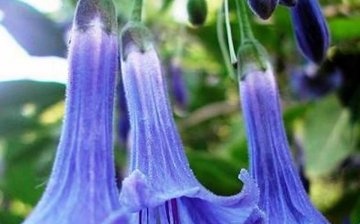
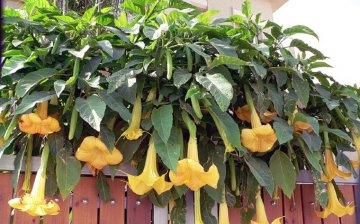
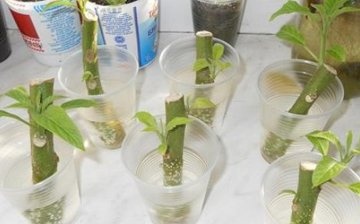
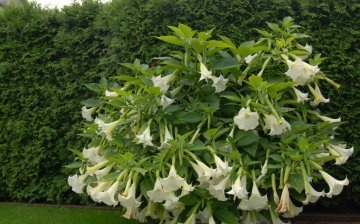
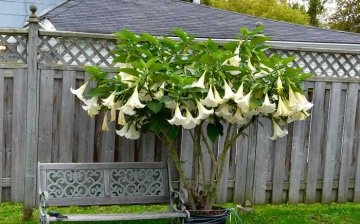
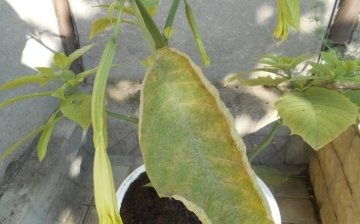








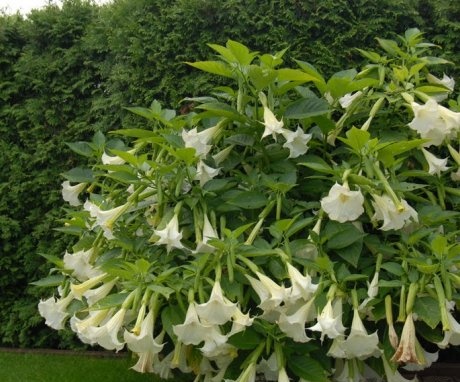
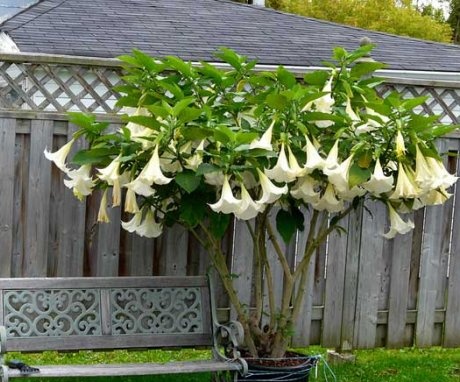
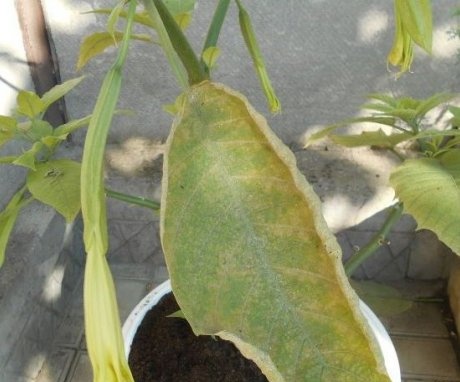
A beautiful plant with flowers that look like a bell. Only, it seems to me, not for the northern territories. Closer to the south, southwest will probably do. And so you have to bring it into the house for the winter.